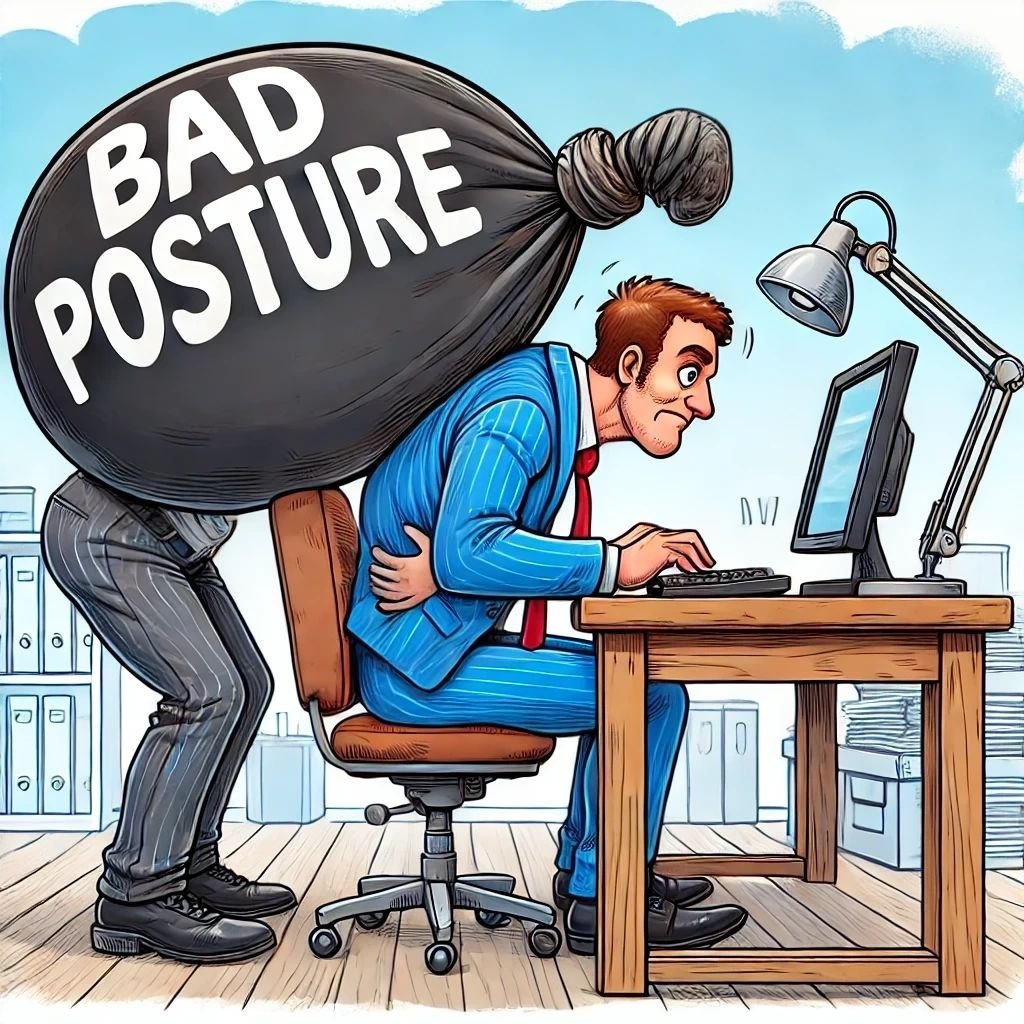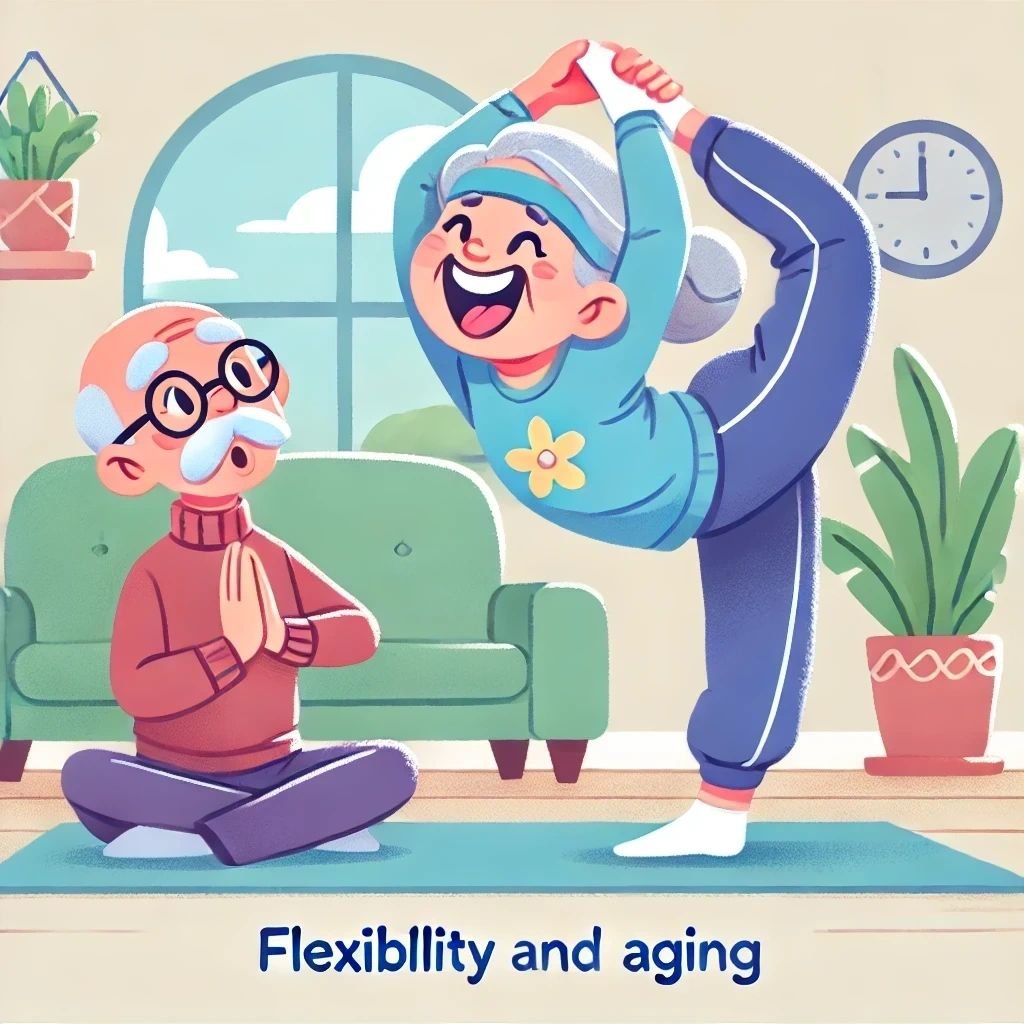We’re going to cover a subject that holds less popularity than strength training or cardio. Bear with me as you’re being treated to a deep dive into why is flexibility important? how to get more flexible. Up until recently, it’s been a severely neglected part of my own fitness journey.
FAQs About Flexibility
1. Why is flexibility important?
Flexibility is essential for improving range of motion, preventing injuries, and enhancing overall physical performance. It helps maintain mobility, balance, and posture, which are particularly crucial as we age.
2. Can flexibility training reduce injuries?
Yes, regular flexibility training improves joint mobility and muscle elasticity, reducing the risk of strains, sprains, and overuse injuries. It also enhances balance and coordination, helping to prevent falls.
3. How often should I stretch to improve flexibility?
Aim to include flexibility exercises at least three times a week. Consistency is key to seeing improvements. A 15-minute routine with dynamic and static stretches is enough to deliver results over time.
4. Does flexibility training improve athletic performance?
Absolutely. Enhanced flexibility allows for greater movement efficiency, improved posture, and reduced muscle tightness, all of which contribute to better performance in sports and physical activities.
5. Can flexibility help with back pain and posture?
Yes, stretching tight muscles and improving mobility can alleviate back pain and correct postural imbalances. Regular flexibility exercises help maintain a neutral spine and reduce strain on the lower back.
6. Is it too late to improve flexibility?
Never. While it’s easier to develop flexibility when younger, consistent stretching can improve flexibility at any age. It’s a gradual process, but persistence delivers results regardless of when you start.
7. What is the best way to start a flexibility routine?
Begin with a 5–10 minute warm-up to prepare your muscles, followed by dynamic stretches before exercise and static stretches post-workout. Yoga and Pilates are also excellent for improving flexibility.
8. Can flexibility exercises alleviate muscle soreness?
Yes. Stretching after exercise improves circulation to muscles, reducing tightness and soreness. It’s like a recovery tool for your muscles, helping them heal and feel better faster.
Why is flexibility important?
Flexibility is the unsung hero of the fitness world. It’s a shame because flexibility is just as pivotal for fitness as strength training and cardio. The importance of flexibility in our overall health and well-being is enormous, and what’s even better is that it doesn’t require a huge time investment.
Despite its numerous benefits, it often gets overshadowed by more glamorous fitness goals. Until relatively recently, I too was guilty of neglecting flexibility. Trust me, your future self will thank you for embracing the stretchy side of life. So, let’s dive into why flexibility is important and how to incorporate a great 15-minute stretching routine.
Why i had To Learn How To Get More Flexible
Around a year and a half ago, I would experience random lower back spasms that would put me out of action for a few days. I attributed this to some past deadlifting form mistakes that had come back to bite me. I also suffered from runner’s knee while running or hiking long distances.
After some enlightenment through my fitness qualification courses, I realised that my ailments were due to a complete lack of flexibility in my body. I’m not the only latecomer who learned how to get more flexible. None other than David Goggins credits his injury recoveries to a flexibility wake-up call.
Unlike Mr Goggins, I don’t stretch for 90 minutes to 2 hours a day. Just 15 minutes, 3-4 times a week, has had a profound impact on my overall fitness. You’re going to receive the same 15-minute stretching routine that I perform.
What is Flexibility?
In its basic form, flexibility is the ability of your muscles and joints to move through their full range of motion. It’s influenced by factors like muscle length, joint structure, and the condition of the surrounding connective tissues. Think of it as the WD-40 for your body – keeping everything moving smoothly. I could certainly get more physiologically technical, but will provide further information via my contact me page if required.
The Benefits of Flexibility
whether your primarily goal is muscle building, cardio fitness or a mixture of both, becoming more flexible has so many benefits which will assist your goals. it’s especially important as we age.
“Stretching and flexibility exercises are essential for improving joint range of motion, reducing the risk of injury, and enhancing athletic performance. Regular flexibility training can also increase circulation and reduce muscle tightness.” – Dr. David Geier, Orthopaedic Surgeon and S
Improved Range of Motion
Imagine trying to reach for the TV remote that’s just out of arm’s length. With better flexibility, you can effortlessly grab it without pulling a muscle. Studies have shown that regular stretching can significantly improve your range of motion, making daily tasks and physical activities much easier.
I personally know of two remote control accidents. A friend of mine, an excellent endurance and overall athlete, tore his hamstring while reaching for a remote control. Since working on his flexibility, he has had no further remote control accidents.

A study published in the Journal of Strength and Conditioning Research (2010) found that regular flexibility training improved range of motion and reduced muscle stiffness in participants, highlighting the importance of stretching in injury prevention.
Enhanced Athletic Performance
Ever seen a gymnast contort their body into seemingly impossible positions? That’s the power of flexibility. Athletes across all disciplines benefit from being more flexible. Research indicates that increased flexibility can enhance performance by improving movement efficiency and reducing the risk of injury. So, whether you’re sprinting, swimming, weightlifting, or practicing your downward dog, flexibility literally has your back.

The Great Gymnastics Tumble of 1932. A gymnast in Paris misjudged a hoop jump, leading to a spectacular tumble that was caught on film and became an early viral comedy clip.
Reduced Muscle Soreness
“While some muscle soreness is inevitable after intense exercise, regular flexibility training can help mitigate this by improving blood flow to muscles and speeding up recovery times.” – Dr. Jonathan Folland, Professor of Human Performance and Neuromuscular Physiology
Post-workout soreness is like a badge of honour for some, but wouldn’t it be nice to wear it less often? Stretching helps reduce muscle soreness by improving circulation and reducing muscle tightness.
A study in The Journal of Applied Physiology (2001) demonstrated that post-exercise static stretching reduced muscle soreness and enhanced recovery by increasing blood circulation to the affected areas.
Better Posture
Slouching can lead to back pain and other issues. Flexibility exercises can help correct postural imbalances by stretching tight muscles and strengthening weak ones. According to a study in the Journal of Physical Therapy Science, regular stretching can significantly improve posture and reduce musculoskeletal discomfort.
Maintaining a neutral spine is crucial to reducing back pain and maintaining the curvature of the spine. Unfortunately, modern-day sitting and general inactivity ensure that deviations from optimal spinal posture are all too common.
If you don’t know what Kyphosis, Lordosis, or Scoliosis are, keep it that way! Understand the answer to Why is flexibility important and don’t neglect stretching!
In addition to the above, ensure you’re balancing your chest exercises with an equal amount of back exercises, or you’ll certainly find out the hard way what muscle imbalances can do to posture!

Stress Relief
Stretching not only benefits the body but also the mind. It helps release tension stored in the muscles, promoting relaxation and reducing stress. So, the next time you’re feeling stressed, instead of reaching for the ice cream, try a good stretch session. If need be, make things fun and simultaneously drink that pint of ice cream whilst attempting to stretch. if you can do this…. do let me know in the comments.

How to Get more flexible: Developing a flexibility Routine
Creating a flexibility routine doesn’t require a master’s in kinesiology, just a little commitment and consistency from you. A sustainable and effective stretching routine can be accomplished in 3-4 15-minute sessions a week.
Becoming more flexible works the same way as becoming fitter. You need to illicit the general adaptation response. The body must be pushed harder than it’s otherwise accustomed to.
Step 1: Warm-Up
Before you start bending and stretching, thinking you’re Mr Fantastic or Stretch Armstrong, warm up your body with 5-10 minutes of light cardio. This increases blood flow to your muscles, making them more pliable and less prone to injury. If you’re at home, running on the spot or doing some star jumps will suffice. It’s easy to wish to save precious time by overlooking the warm-up, but you’ll get more out of your session if you comply.

Step 2: Dynamic Stretching
Dynamic stretching involves moving parts of your body through their full range of motion in a controlled manner. It’s like a rehearsal for your muscles. Examples include leg swings, arm circles, and torso twists.
Step 3: Static Stretching
Static stretching involves holding a stretch for 15-60 seconds. It’s best done after workouts when your muscles are warm. Focus on major muscle groups like the hamstrings, quadriceps, calves, hip flexors, chest, shoulders, and back.
Step 4: Yoga and Pilates
If you haven’t tried yoga or Pilates, you’re missing out on some serious flexibility gains. These disciplines emphasise stretching, controlled movements, and breathing techniques, which collectively improve muscle elasticity and joint mobility. Plus, they come with the added benefit of looking super zen if you decide to post on social media. I must confess, step 4 is one too far for me, and I’ve never indulged in yoga or Pilates. My lack of interest doesn’t prevent me from attempting these sessions, but I simply lack the time. If I manage to fit this into my busy life, I shall report back.
The Yoga Class Chain Reaction
In the 1990s, an overenthusiastic yogi in New York caused a domino effect by toppling an entire row of practitioners during a pose, becoming a local legend.
Step 5: Consistency is Key
Flexibility improvements don’t happen overnight; consistency is crucial. Aim to include flexibility exercises in your routine at least three times a week.
A 15-Minute Stretching Routine: How To Get More Flexible
The Cirque du Soleil Contortionist Mix-Up
In 2005, two contortionists in Las Vegas swapped positions mid-routine, leading to comedic mishaps that the audience thought were part of the act, earning rave reviews.
Factoring in the above, here’s a sample routine to get you started. It’s the exact flexibility routine I practice. It’s nothing groundbreaking, but it has given me some great benefits.
Warm-Up
5 minutes of light cardio (e.g. star jumps/running on the spot). If you slot this in straight after a strength or cardio workout, you can skip this part. Do ensure that you’re warm. Muscles don’t like cold stretching. You don’t want your first outcome post learning how to get more flexible being a trip to A and E
Dynamic Stretches
- Arm circles: 10 rotations forward and 10 backward.
- Leg swings: 10 swings forward and backward for each leg.
- Torso twists: 10 twists to each side.
Static Stretches
For static stretches you should be stretching to a level of notable discomfort, but certainly not to pain levels. Ease into the stretch for the first 10 seconds and go for it for the last 20. How to get more flexible isn’t about extreme pain, it should be all about slight discomfort.
In the event any below uploads below are removed (I endeavour to regularly update posts), I’d strongly recommend the AskDoctorJo YouTube channel (she knows everything covering how to get more flexible)for advanced flexibility, injury treatment stretches/routines and general further viewing. the below stretches are common enough to quickly locate online demonstrations
Hip Flexor Lunge stretch: Hold for 30 seconds on each leg
Hamstring stretch: Hold for 30 seconds on each leg.
Quadriceps stretch: Hold for 30 seconds on each leg (you can also do perform this leaning against something,
Calf stretch: Hold for 30 seconds on each leg.
Chest stretch: Hold for 30 seconds Each side
Shoulder stretch: Hold for 30 seconds on each arm.
Back Press: (just the first part of the upload) 30 second hold each side
Superman spine stretch: Hold for 30 seconds
Side Splits stretch: 30 second hold
IT Band Stretch (THIS WAS A GOD SEND FOR MY IT BAND ISSUES- SEE BELOW) 30 reps each leg
Cool Down
Deep breathing for 5 minutes.
Why Is Flexibility Important? Injury Prevention
Flexibility plays a crucial role in injury prevention by improving joint mobility and muscle elasticity. When muscles are flexible, they can move more freely, reducing the risk of strains and sprains. Regular stretching enhances balance and coordination, which helps prevent falls and related injuries, particularly in older adults. Trust me, nothing wakes you up more to asking the question why is flexibility important than an injury. Especially a preventable injury.
“Injury prevention is one of the primary benefits of flexibility. Stretching not only reduces muscle tightness but also enhances circulation and neuromuscular coordination, lowering the likelihood of strains and sprains.” – Dr. Mike Reinold, Physical Therapist and Performance Enhancement Specialist
Moreover, flexibility exercises alleviate muscle tension and distribute physical stress more evenly across the body, minimising the chances of overuse injuries.
The top injuries caused by lack of flexibility are:
- Muscle Strains
Tight muscles are more prone to overstretching and tearing during physical activity. Lack of flexibility reduces the muscle’s ability to extend properly, leading to strains. - Joint Sprains
Inflexible muscles around the joints can limit their range of motion. This restriction can cause joints to move improperly or excessively under stress, leading to sprains. - Back Pain
Tight hamstrings and hip flexors can alter pelvic alignment and strain the lower back. Poor flexibility in these areas increases the risk of chronic back pain and discomfort. - Tendonitis
Inflexibility can cause repetitive stress on tendons, leading to inflammation and tendonitis. Tight muscles limit movement efficiency, increasing strain on tendons. - Plantar Fasciitis
Tight calf muscles can increase the tension on the plantar fascia, the tissue connecting the heel to the toes. Lack of flexibility in the calves contributes to the development of this painful foot condition.
Research published in The American Journal of Sports Medicine (2005) found that a regular stretching routine reduced the incidence of muscle strains and joint sprains in athletes by improving muscle elasticity and joint mobility.
The Olympic Splits Incident
At the 1988 Seoul Olympics, a gymnast’s mid-air split ended in an unintentional slide across the mat, creating one of the most memorable and humorous moments of the games.
How Lack of Flexibility Can Cause Runner’s Knee
Although this is coined as runner’s knee, it can impact hikers and general walkers. I should know—I used to suffer from this issue frequently, so much that it’s got its own section.
Tight muscles around the knee, such as the quadriceps, hamstrings, and IT band, can alter biomechanics and contribute to conditions like patellofemoral pain syndrome. Proper stretching can prevent these issues and reduce pain.” – Dr. Jordan Metzl, Sports Medicine Physician
All exercises within the sample flexibility routine above will assist with runner’s knee.
Lack of flexibility can significantly impact runner’s knee, also known as patellofemoral pain syndrome (PFPS), in several ways:
- Tight Quadriceps and Hamstrings
Inflexible quadriceps and hamstrings can exert excessive pressure on the knee joint. Tight quadriceps pull on the patella (kneecap), disrupting its alignment and causing pain. Similarly, tight hamstrings can limit the knee’s range of motion, contributing to improper mechanics during running. - Iliotibial (IT) Band Tightness
The IT band runs along the outside of the thigh from the hip to the knee. Lack of flexibility in this band can cause it to rub against the outer part of the knee, leading to inflammation and pain commonly associated with runner’s knee. - Hip Flexor Inflexibility
Tight hip flexors can alter your running gait, forcing the knee to compensate for restricted hip movement. This additional stress on the knee joint can exacerbate or lead to runner’s knee. - Calf Muscle Tightness
Inflexible calf muscles can affect the way the foot strikes the ground, causing abnormal stress on the knee joint. This improper alignment and impact distribution can contribute to the development of runner’s knee. - Limited Ankle Mobility
Lack of flexibility in the ankle can lead to compensatory movements in the knee during running. Restricted ankle dorsiflexion (the ability to flex the foot upwards) forces the knee to absorb more shock and pressure, increasing the risk of runner’s knee.
A study in The Journal of Orthopaedic & Sports Physical Therapy (2014) found that IT band stretching combined with strengthening exercises significantly reduced symptoms of runner’s knee in patients with patellofemoral pain syndrome.
I included the IT band stretch within the above 15-minute stretching routine. This stretch can’t be praised enough.
I suffered with runners knee during my 10 y fan endurance challenge and certainly would have mitigated this risk with greater flexibility.
Flexibility and Ageing
As we age, our muscles naturally lose elasticity, and our joints become stiffer. This can lead to a decreased range of motion, making everyday activities more challenging. However, incorporating flexibility exercises into your strength training and cardio routine can combat these age-related changes and keep you moving smoothly. Flexibility and ageing must go hand in hand. Why is flexibility important as you age? Your quality of life will thank you for learning how to get more flexible.
“As we age, maintaining flexibility becomes more important for preserving mobility, reducing joint pain, and preventing falls. Stretching helps keep muscles pliable and joints mobile, supporting overall functional independence.” – Dr. Heidi Prather, Specialist in Physical Medicine and Rehabilitation
Enhancing Quality of Life
Overall, maintaining flexibility as you age contributes to a higher quality of life. It allows you to stay active, participate in hobbies and social activities, and enjoy a greater sense of well-being. So, don’t let age be an excuse – keep stretching and stay limber!
Maintaining Independence
Flexibility is crucial for maintaining independence as you age. Simple tasks like bending to tie your shoes, reaching for items on a high shelf, or getting up from a chair can become difficult without sufficient flexibility. Regular stretching can help preserve your ability to perform these daily activities independently.
Reducing Risk of Falls
Falls are a major concern for older adults, often leading to serious injuries. Improved flexibility enhances balance and coordination, which are key factors in preventing falls. Studies have shown that older adults who engage in regular flexibility and balance exercises are less likely to experience falls.
A 2019 study in The Journal of Geriatric Physical Therapy found that a consistent flexibility routine significantly reduced the risk of falls in older adults, improving their balance and overall mobility.
Alleviating Arthritis Symptoms
Arthritis is a common condition among older adults, causing joint pain and stiffness. Flexibility exercises can help alleviate these symptoms by keeping the joints mobile and reducing stiffness. Gentle stretching can also improve circulation, bringing more nutrients and oxygen to the affected areas.

The Yoga Pants Rip. In 2014, a fitness expert on a UK morning show ripped his yoga pants during a live demonstration, leading to laughter and a viral clip.
Key Takeaways
- Why is flexibility important? It helps improve your range of motion and reduces injury risks.
- Flexibility enhances posture and can alleviate muscle soreness.
- How to get more flexible: Regular dynamic and static stretching, along with yoga or Pilates, can boost flexibility.
- Flexibility is essential for overall fitness, daily activities, and maintaining independence as you age.
- Consistency is key—stretching just a few times a week can deliver lasting benefits.
Conclusion
Thanks for reading Why is flexibility important: How to get more flexible. A 15-minute stretching routine, for as little as three times a week, is all that’s needed to reap the benefits of flexibility training.
Flexibility is a fundamental aspect of physical fitness that offers numerous benefits, from improved range of motion and athletic performance to reduced muscle soreness and better posture. Developing a regular flexibility routine and understanding its role in injury prevention can enhance your overall health and well-being.
Remember to stay consistent and listen to your body, making adjustments as needed. I’ve set you on your merry way with an effective total body routine, but there are many sources of rich and diverse information and more complex routines available online.
In summary, the importance of flexibility cannot be overstated. It is an integral part of maintaining a balanced and effective fitness routine. Whether you’re an athlete looking to improve performance, someone aiming for better overall health, or looking to injury-proof yourself into old age, flexibility should be a key component of your fitness strategy. So, start stretching and reap the long-term benefits.
Thank you very much for your time in reading this article. I hope it added value to you.
Chat soon,
Matt.


4 thoughts on “Why is Flexibility Important? How To Get More Flexible”
Comments are closed.